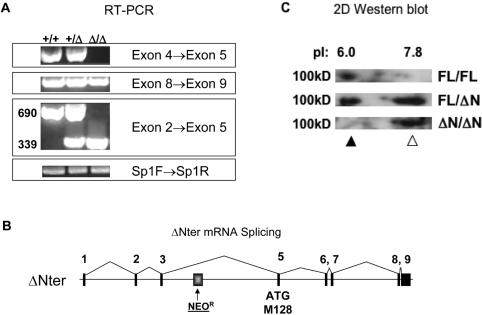Figure 4.
ΔExon4 locus encodes mouse ZBP-89ΔN. (A) RT–PCR analysis was used to determine the variant mRNA structure in recombinant mice. Spleen whole-cell RNA was reverse-transcribed and amplified with primers within the indicated exons. RT–PCR of another ubiquitously expressed zinc-finger transcription factor, Sp1, was used for comparison and showed that the RNA samples were of uniform quality. Control experiments showed that PCR products were RT-dependent (data not shown), indicating that they were indeed derived from mRNA rather than possibly resulting from amplification of ZBP-89 related processed pseudogene sequences, such as ΨBERF1 (32). (B) DNA sequencing of recombinant cDNA showed that deletion of exon 4 resulted in direct splicing of exon 3 to exon 5, excluding the Neo cassette. The resulting reading frameshift predicts an alternative initiation codon corresponding to M128 of FL protein, similar to the naturally occurring human ZBP-89ΔN variant. (C) 2D immunoblot analysis of whole-cell spleen protein extracts from FL/FL, FL/ΔN and ΔN/ΔN mice, using conditions identical to those used for analysis of human samples (Figure 2C).

